Ted Bohus: The Deadly Interview – Part 1
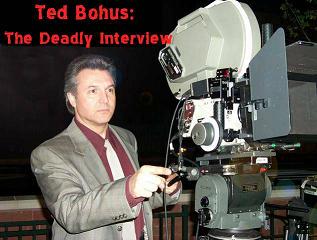 While millions of people in this world may consider themselves Fanboys of one type or another, it is only a lucky few who get to realize their dreams and join the ranks of the filmmakers they admire. Ted Bohus is a genuine “monster kid”, a product of the Famous Monsters of Filmland generation, who turned his obsession with movies into a paying job. When he created his first feature film, The Deadly Spawn, he inspired the next generation of film fans with a low budget cult classic that just barely managed to grab on to the last wave of theatrical distribution for independent films. Conducting an interview with Ted is more like meeting a new friend at a science fiction convention or even the local comic shop. You may have never met this person before but you know instinctively that you share the common bond of fandom. When we could steer ourselves away from talking about movie posters, 16mm films, and The Beatles, Ted and I were actually able to discuss his career in filmmaking.
While millions of people in this world may consider themselves Fanboys of one type or another, it is only a lucky few who get to realize their dreams and join the ranks of the filmmakers they admire. Ted Bohus is a genuine “monster kid”, a product of the Famous Monsters of Filmland generation, who turned his obsession with movies into a paying job. When he created his first feature film, The Deadly Spawn, he inspired the next generation of film fans with a low budget cult classic that just barely managed to grab on to the last wave of theatrical distribution for independent films. Conducting an interview with Ted is more like meeting a new friend at a science fiction convention or even the local comic shop. You may have never met this person before but you know instinctively that you share the common bond of fandom. When we could steer ourselves away from talking about movie posters, 16mm films, and The Beatles, Ted and I were actually able to discuss his career in filmmaking.
ED Tucker: You obviously were a film fan growing up, based on your short films that are included on The Deadly Spawn DVD as bonuses. What got you interested in making your own films?
Ted Bohus: In the very beginning, my friend, Charlie Chubak, and I started making Super 8 films back in high school. We would buy 8mm films from Blackhawk, like Laurel and Hardy. These were silent films and at the time, you could send silent films out to be sound striped. They would put a stripe on them that you could actually record sound on. We would take these movies and sit with all kinds of stuff around us – pots, pans, whistles, and boxing gloves, anything you can imagine. We would go through the entire film and put our own sound effects on it – live as it was happening. We would try to fill in with stupid dialog, half the time it was dirty with us trying to imitate the voices of Laurel and Hardy. It was hilarious; we had a great time with that. That’s when we first started getting interested in film. We started doing shorts and I thought I was going to get into stop motion animation. There was a Kodak contest one time for stop motion animation and I spent about three months working my butt off on a short film. It involved clay and sand and all kinds of stuff. I sent in the film and I never got a reply – they lost the film! As a consolation, they sent me three reels of film. I thought they had to be kidding! After that I was so demoralized I knew I could never have that happen to me again and I just stopped animating.
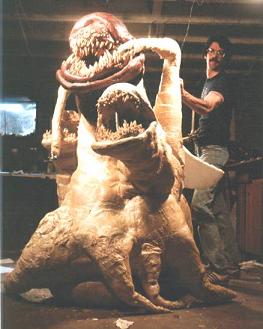
John Dods builds the main spawn creature.
ET: How did you get involved with Don Dohler?
TB: I still wanted to get into film one way or the other. We had a network of people who would go to a lot of the fan conventions in the 70’s and a lot of us met that way. A lot of people who have gone on to be big in the business would meet up at these conventions and watch each other’s films. I met Don Dohler through this network and we decided to partner up and do Nightbeast and Fiend. There were two versions of Nightbeast. I kept telling Don you need to put more gore and action in the film but Don liked to do everything himself. We started doing the first version of Nightbeast and my friend John Dods, who did Deadly Spawn with me, we designed the creature and we had input into the story. That version of the film fell apart because Don hired some guy to be the director and they had a falling out or something, I don’t remember the whole story.
ET: When that happened Don Dohler rushed into production on Fiend to keep everyone together from the Nightbeast shoot and keep the moment rolling.
TB: Right, I was one of the producers on Fiend. I think I came up with ending on that but I don’t remember it very well either. After that, Don made the second version of Nightbeast which was completed. At one point I decided the trip back and forth to Baltimore was killing me and eventually you just want to do your own thing. I called up John Dods and said “Hey, how would you like to make a film of our own, right here in Jersey?” He said “Yeah, let’s do it” and it started as fast as that. We decided to do a monster movie for our first film because they sell and were popular at the time. I wanted to design a creature that hadn’t been seen before, something kind of clever. I drew out a bunch of designs. I had read a story about scientists finding artic seed pods, I don’t know how long they had been dormant but after they planted them they grew. I thought why don’t we have a meteor come down with a dormant thing in it. Of course, at the time, I didn’t realize that this was the same story as The Blob; I thought I had come up with a great idea!
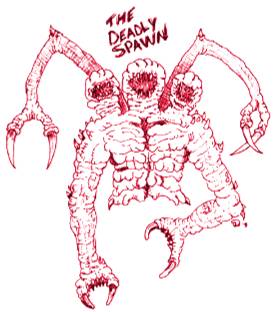
Ted Bohus' original concept art for the main creature.
ET: Were any of the designs that you drew similar to the finished creature?
TB: Yes, pretty much. When I drew these things out, this is where I thought I was being clever; this thing was going to be a big stalk of a creature with arms that were bent in different directions. The thing had three snake-like heads. The one in the middle was going to be a mask and the two heads on the side would be controlled by puppeteers from behind. The two arms that had pinchers on the end would be operated by puppeteers as well. Whenever this thing was walking around, it would have these three heads and four arms moving around. I thought it was kind of a cool thing because I hadn’t seen anything like that before. We’re talking 1979 here. I took the designs to John and he said “It’s a great idea but do we have to do another guy in a suit?” I said “No, we don’t. It’s just money! If you can do something else with the same amount of money we have to do that, we’ll do it.” I told him to keep that basic idea, three heads, a lot of teeth, pinchers, – I want that design to stay but anything you can do that doesn’t have a body is fine. He came up with some sketches – some were pretty bizarre and some we just couldn’t do on our budget. He came up with one though where he took the body and put it all together so that it was just a trunk with three heads and the pinchers coming out on the top. At the bottom, instead of having legs, he had tentacles coming out of it. I thought that one was the closet to the original flavor.
ET: What was your initial budget for the film?
TB: We had nineteen thousand and something hundred dollars to do this movie when we started in 1980. It was ridiculous! As a comparison, I think Sam Rami had one hundred and fifty thousand to do Evil Dead. Just as a sidebar, Sam and I were using the same lab in the city to do our films. He was doing Book of the Dead, the original title of Evil Dead, and I was doing Deadly Spawn and we would compare footage. He came into the lab one day and said “Ted, I may have a title change for the film, what do you think of this title – Evil Dead?” I said “Eh, I really like Book of the Dead better.” It goes to show you what I know!
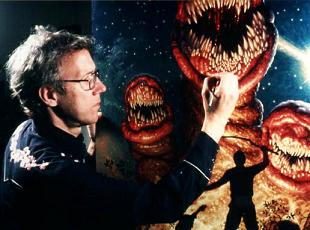
Tim Hildebrandt paints the artwork for the Deadly Spawn poster.
ET: In retrospect, I would have to agree with you. Evil Dead sounds rather generic, Book of the Dead sounds like there is more meat to it.
TB: To me, Book of the Dead just sounded like a good title. Evil Dead sounded weird to me at the time. Now, we’re so used to that title it is hard to imagine it being called anything else. It just made more sense to me because there’s a book of the dead in the film. Go figure, his film went on to be very successful. We opened at the same time on Broadway in New York. We went to see Sam’s film and he went to see ours. I thought, look what we’ve done on a fraction of his budget. Imagine what we could have done with one hundred and fifty thousand! We had very talented people. We had Tim Hildebrandt; he got his start in film making and was familiar with it. He was an artist, he could build things, and we even shot in his house. To have someone like him as your art director and helping out was just great.
ET: Of course his son, Charles, was your lead actor. Did you see his character as an amalgam of you and your friends when you were growing up?
TB: Yes, it was that type of thing. The things in his room were a lot of stuff from my collection. I picked stuff that I knew might get ruined. At the time I had hundreds and hundreds of posters. For the basic story, I wanted a meteor to come down and the creature comes out. It kills some campers and eventually gets into a house, traps some people in there, and then we have the big ending. That was all I had. At the very beginning of the film, I wanted to design the creatures, I wanted to write the story, I wanted direct the film, produce it – I wanted to do everything. We didn’t have any money to hire anybody!
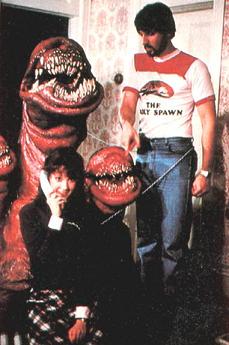
Actress Jean Tafler's phone call is about to be cut short!
ET: You didn’t want to do all those things out of narcissism, it was out of necessity.
TB: That’s it exactly. We just didn’t have any money. We had nineteen thousand five hundred dollars. John and I were also both working full time jobs at the time. John told me he had a friend, Doug McKeown, who worked in the city with actors and doing plays. He said if we brought him on board he could help with the writing and direct the film. We met with him and he seemed like a very nice guy. That’s how the film started, as simple as that. The toughest part was when we started auditioning actors and trying to get a camera crew. At first, as we were doing the film, I thought I can’t believe this is so easy – everything is falling into place. We had put out an ad and a guy came in who had all the equipment – sound equipment, lights, cameras, everything. Two weeks before we started production, he called me up and said he had to drop out because he had a paying job. I said “Are you out of your mind? We shoot in two weeks!” I hung up the phone and I didn’t know what to do. I made phone call after phone call, I couldn’t find anybody. It was two weeks before shooting, I thought this was so easy and it had just come back and kicked me square in the ass! I had no answers, no money, it was horrible. About a week before shooting, one of the guys who had originally said he couldn’t do the film called me back and said he was available, so we used his equipment.
ET: What was the filming schedule like?
TB: We shot on weekends. We had one week that everybody took off work and we shot for a week straight. The rest of it was just shot on weekends. It took about a year to film, it was pretty crazy. We had actors who had to drop out and we had to change parts around for that. The blonde girl was supposed to die and the brunette, Jean Tafler, was supposed to survive. Jean got a job acting in a play and had to drop out so I told her “Guess what? Now you’re the one who gets her head bit off and dropped out a window!”
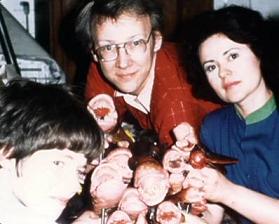
The Hildebrandt family meets the spawn family.
ET: The beauty of it is no one notices that when they see the movie, it still makes sense.
TB: Right, we had shot so long that Richard Porter came back at the end and had his curly hair cut short! We just spritzed it down and hoped no one would notice. No one ever has either, no one ever mentions that his hair is totally shorter at the end than it is in the rest of the picture.
ET: Those were the scenes in the attic and in the close ups it looks like the actors are really sweating. It’s very believable that it was hot up there and his hair is matted down from sweat.
TB: It was hot in that attic! At one point, we had a thermometer up there that went to a hundred and something degrees and it exploded! It was over 110 degrees up there and we had people inside the spawn. We would hear a “thunk” when someone passed out and hit the ground and we would have to get them out. Then we would put someone else inside until they fainted!
Coming Next Week in The Deadly Interview Part 2: Distribution dilemmas, prop destruction, and life after The Deadly Spawn!
